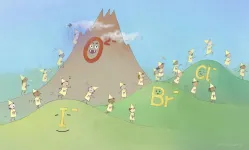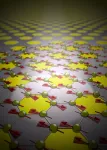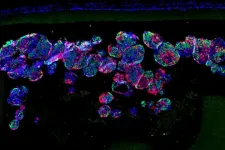(Press-News.org) ITHACA, N.Y. - All fish are not created equal, at least when it comes to nutritional benefits.
This truth has important implications for how declining fish biodiversity can affect human nutrition, according to a computer modeling study led by Cornell and Columbia University researchers.
The study, "Declining Diversity of Wild-Caught Species Puts Dietary Nutrient Supplies at Risk," published May 28 in Science Advances, focused on the Loreto region of the Peruvian Amazon, where inland fisheries provide a critical source of nutrition for the 800,000 inhabitants.
At the same time, the findings apply to fish biodiversity worldwide, as more than 2 billion people depend on fish as their primary source of animal-derived nutrients.
"Investing in safeguarding biodiversity can deliver both on maintaining ecosystem function and health, and on food security and fisheries sustainability," said the study's first author Sebastian Heilpern, a presidential postdoctoral scholar in the Department of Natural Resources and the Environment at Cornell University.
Practical steps could include establishing and enforcing "no-take zones" - areas set aside by the government where natural resources can't be extracted - in critical habitat; making sure that fishers adhere to fish size limits; and an increased investment in gathering species data to inform fisheries management policies, especially for inland fisheries.
In Loreto, people eat about 50 kilograms of fish annually per capita, rivaling the highest fish consumption rates in the world, and about half the amount of meat an average American consumes each year. Loreto residents eat a wide variety of fish, approximately 60 species, according to catch data. Species include large predatory catfish that migrate more than 5,000 kilometers, but whose numbers are dwindling due to overfishing and hydropower dams that block their paths. At the same time, the amount of fish caught has remained relatively consistent over time. This could be due to people spending more time fishing and smaller, more sedentary species or other predators filling voids left by dwindling larger predator populations.
"You have this pattern of biodiversity change but a constancy of biomass," Heilpern said. "We wanted to know: How does that affect nutrients that people get from the system?"
In the computer model, the researchers took all these factors into account and ran extinction scenarios, looking at which species are more likely to go extinct, and then which species are likely to replace those to compensate for a void in the ecosystem.
The model tracked seven essential animal-derived nutrients, including protein, iron, zinc, calcium and three omega-3 fatty acids, and simulated how changing fish stocks might affect nutrient levels across the population. While protein content across species is relatively equal, smaller, more sedentary fish have higher omega-3 content. Levels of micronutrients such as zinc and iron can also vary between species.
Simulations revealed risks in the system. For example, when small, sedentary species compensated for declines in large migratory species, fatty acid supplies increased, while zinc and iron supplies decreased. The region already suffers from high anemia rates, caused by iron deficiency, that such outcomes could further exacerbate.
"As you lose biodiversity, you have these tradeoffs that play out in terms of the aggregate quantity of nutrients," Heilpern said. "As you lose species, the system also becomes more and more risky to further shocks."
A related paper published March 19 in Nature Food considered whether other animal-based food sources, such as chicken and aquaculture, could compensate for the loss of biodiversity and dietary nutrients in the same region. The researchers found that those options were inadequate and could not replace the nutrients lost when fish biodiversity declines.
INFORMATION:
The study was funded by a Columbia University Dean's Diversity Fellowship, a New York Community Trust Edward Prince Goldman Scholarship in Science, and a grant from the Conservation, Food and Health Foundation.
Researchers at Kyoto University's Institute for Cell-Material Sciences (iCeMS) have developed a new approach to speed up hydrogen atoms moving through a crystal lattice structure at lower temperatures. They reported their findings in the journal Science Advances.
"Improving hydrogen transport in solids could lead to more sustainable sources of energy," says Hiroshi Kageyama of iCeMS who led the study.
Negatively charged hydrogen 'anions' can move very quickly through a solid 'hydride' material, which consists of hydrogen atoms attached to other chemical elements. This system is a promising contender for clean energy, but the fast ...
Stone tools have been made by humans and their ancestors for millions of years. For archaeologists these rocky remnants - lithic artefacts and flakes - are of key importance. Because of their high preservation potential they are among the most common findings in archaeological excavations. Worldwide, numerical dating of these lithic artefacts, especially when they occur as surface findings, remains a major challenge. Usually, stone tools cannot be dated directly, but only when they are embedded in sediment layers together with, for example, organic material. The age of such organic material can be constrained via the radiocarbon technique. If such datable organic remains are ...
Tested on human blood in the lab, the selective nanocapsules could reduce the side effects of a major blood clot dissolving drug, which include bleeding on the brain. If confirmed with animal tests, the nanocapsules could also make the drug more effective at lower doses.
Blood clots, also known as thrombi, are a key cause of strokes and heart attacks which are leading causes of death and ill-health worldwide. They can be treated with a clot dissolving drug called tissue plasminogen activator (tPA) which disrupts clots to clear the blocked blood vessel and re-establish blood ...
Known as nature's own sonar system, echolocation occurs when an animal emits a sound that bounces off objects in the environment, returning echoes that provide information about the surrounding space.
While echolocation is well known in whale or bat species, previous research has also indicated that some blind people may use click-based echolocation to judge spaces and improve their navigation skills.
Equipped with this knowledge, a team of researchers, led by Dr Lore Thaler, of Durham University, UK, delved into the factors that determine how people learn this skill.
Over the course of a 10-week training programme, the team investigated how blindness and age affect learning ...
Atomically thin van der Waals magnets are widely seen as the ultimately compact media for future magnetic data storage and fast data processing. Controlling the magnetic state of these materials in real-time, however, has proven difficult. But now, an international team of researchers led by Delft University of Technology (TU Delft) has managed to use light in order to change the anisotropy of a van der Waals antiferromagnet on demand, paving the way to new, extremely efficient means of data storage.
The thin atomic layers that make up van der Waals magnets may seem extremely fragile, but they can be about 200 times stronger ...
In a six-month study of more than 1,000 Americans, R. Kelly Garrett and Robert Bond found that U.S. conservatives were less able to distinguish truth from falsehoods in 20 viral political news stories that appeared online between January and July 2019. Differences in the political orientation of these stories may help explain this observation, the researchers note, writing that "we find that high-profile true political claims tend to promote issues and candidates favored by liberals, while falsehoods tend to be better for conservatives." Two-thirds (65%) of the high-profile true stories were characterized as benefiting the political left, compared with only 10% that were described as benefiting the political right. Among high-profile false stories, 45.8% were perceived to benefit the ...
Individuals at higher risk of developing pancreatic cancer could be identified earlier using machine learning (ML) techniques which would result in a greater number of patients surviving the disease, suggests a new study published in PLOS ONE.
The study was led by the London School of Hygiene & Tropical Medicine (LSHTM) and funded by the UK charity Pancreatic Cancer Research Fund (PCRF).
It used UK electronic health records for more than 1,000 patients aged 15-99 years who were diagnosed with pancreatic cancer between January 2005 and June 2009.
The researchers examined numerous symptoms and ...
A team of researchers led by diabetes specialists and biomedical engineers at Washington University School of Medicine in St. Louis and Cornell University has demonstrated that, using a miniscule device, they can implant insulin-secreting cells into diabetic mice. Once implanted, the cells secrete insulin in response to blood sugar, reversing diabetes without requiring drugs to suppress the immune system.
The findings are published June 2 in the journal Science Translational Medicine.
"We can take a person's skin or fat cells, make them into stem cells and then grow those stem cells into insulin-secreting cells," said Jeffrey R. Millman, PhD, an associate professor of medicine at Washington ...
A new study reveals that B cells can produce antibodies against the H1N1 influenza virus that also neutralize various other influenza strains, marking a development that could inform research into potential universal flu vaccines. The findings showed that the antibodies targeted two conserved regions of the virus - the cause of the 2009 swine flu pandemic - and that transfers of the antibodies protected mice from lethal infection. The work suggests that vaccines that target the two sites might be able to protect against a broader array of flu strains. Influenza is one of humanity's greatest microbial ...
RICHLAND, Wash.--Scientists have created a cybersecurity technology called Shadow Figment that is designed to lure hackers into an artificial world, then stop them from doing damage by feeding them illusory tidbits of success.
The aim is to sequester bad actors by captivating them with an attractive--but imaginary--world.
The technology is aimed at protecting physical targets--infrastructure such as buildings, the electric grid, water and sewage systems, and even pipelines. The technology was developed by scientists at the U.S. Department of Energy's Pacific Northwest National Laboratory.
The starting point for Shadow Figment is an oft-deployed technology called a honeypot--something attractive to lure an attacker, perhaps a desirable target with the appearance of easy access.
But ...



